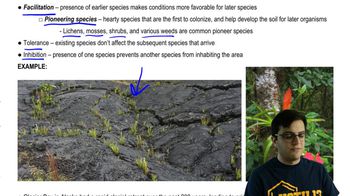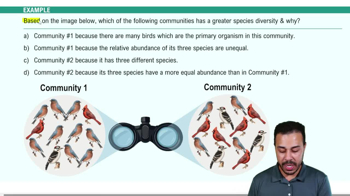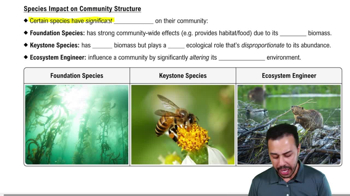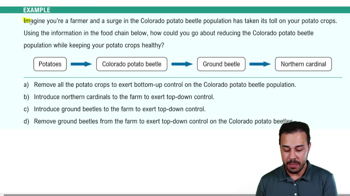Table of contents
- 1. Introduction to Biology2h 42m
- 2. Chemistry3h 40m
- 3. Water1h 26m
- 4. Biomolecules2h 23m
- 5. Cell Components2h 26m
- 6. The Membrane2h 31m
- 7. Energy and Metabolism2h 0m
- 8. Respiration2h 40m
- 9. Photosynthesis2h 49m
- 10. Cell Signaling59m
- 11. Cell Division2h 47m
- 12. Meiosis2h 0m
- 13. Mendelian Genetics4h 44m
- Introduction to Mendel's Experiments7m
- Genotype vs. Phenotype17m
- Punnett Squares13m
- Mendel's Experiments26m
- Mendel's Laws18m
- Monohybrid Crosses19m
- Test Crosses14m
- Dihybrid Crosses20m
- Punnett Square Probability26m
- Incomplete Dominance vs. Codominance20m
- Epistasis7m
- Non-Mendelian Genetics12m
- Pedigrees6m
- Autosomal Inheritance21m
- Sex-Linked Inheritance43m
- X-Inactivation9m
- 14. DNA Synthesis2h 27m
- 15. Gene Expression3h 20m
- 16. Regulation of Expression3h 31m
- Introduction to Regulation of Gene Expression13m
- Prokaryotic Gene Regulation via Operons27m
- The Lac Operon21m
- Glucose's Impact on Lac Operon25m
- The Trp Operon20m
- Review of the Lac Operon & Trp Operon11m
- Introduction to Eukaryotic Gene Regulation9m
- Eukaryotic Chromatin Modifications16m
- Eukaryotic Transcriptional Control22m
- Eukaryotic Post-Transcriptional Regulation28m
- Eukaryotic Post-Translational Regulation13m
- 17. Viruses37m
- 18. Biotechnology2h 58m
- 19. Genomics17m
- 20. Development1h 5m
- 21. Evolution3h 1m
- 22. Evolution of Populations3h 52m
- 23. Speciation1h 37m
- 24. History of Life on Earth2h 6m
- 25. Phylogeny2h 31m
- 26. Prokaryotes4h 59m
- 27. Protists1h 12m
- 28. Plants1h 22m
- 29. Fungi36m
- 30. Overview of Animals34m
- 31. Invertebrates1h 2m
- 32. Vertebrates50m
- 33. Plant Anatomy1h 3m
- 34. Vascular Plant Transport1h 2m
- 35. Soil37m
- 36. Plant Reproduction47m
- 37. Plant Sensation and Response1h 9m
- 38. Animal Form and Function1h 19m
- 39. Digestive System1h 10m
- 40. Circulatory System1h 57m
- 41. Immune System1h 12m
- 42. Osmoregulation and Excretion50m
- 43. Endocrine System1h 4m
- 44. Animal Reproduction1h 2m
- 45. Nervous System1h 55m
- 46. Sensory Systems46m
- 47. Muscle Systems23m
- 48. Ecology3h 11m
- Introduction to Ecology20m
- Biogeography14m
- Earth's Climate Patterns50m
- Introduction to Terrestrial Biomes10m
- Terrestrial Biomes: Near Equator13m
- Terrestrial Biomes: Temperate Regions10m
- Terrestrial Biomes: Northern Regions15m
- Introduction to Aquatic Biomes27m
- Freshwater Aquatic Biomes14m
- Marine Aquatic Biomes13m
- 49. Animal Behavior28m
- 50. Population Ecology3h 41m
- Introduction to Population Ecology28m
- Population Sampling Methods23m
- Life History12m
- Population Demography17m
- Factors Limiting Population Growth14m
- Introduction to Population Growth Models22m
- Linear Population Growth6m
- Exponential Population Growth29m
- Logistic Population Growth32m
- r/K Selection10m
- The Human Population22m
- 51. Community Ecology2h 46m
- Introduction to Community Ecology2m
- Introduction to Community Interactions9m
- Community Interactions: Competition (-/-)38m
- Community Interactions: Exploitation (+/-)23m
- Community Interactions: Mutualism (+/+) & Commensalism (+/0)9m
- Community Structure35m
- Community Dynamics26m
- Geographic Impact on Communities21m
- 52. Ecosystems2h 36m
- 53. Conservation Biology24m
51. Community Ecology
Community Structure
Problem 8`
Textbook Question
The most plausible hypothesis to explain why species richness is higher in tropical than in temperate regions is that
a. Tropical communities are younger.
b. Tropical regions generally have more available water and higher levels of solar radiation.
c. Higher temperatures cause more rapid speciation.
d. Diversity increases as evapotranspiration decreases.
 Verified step by step guidance
Verified step by step guidance1
Understand the concept of species richness, which refers to the number of different species represented in an ecological community, landscape, or region.
Consider the environmental factors that can influence species richness, such as climate, availability of resources, and ecological interactions.
Evaluate the hypothesis that tropical regions generally have more available water and higher levels of solar radiation, which can support a greater diversity of life forms. This is because these conditions can enhance primary productivity, providing more energy and resources for a variety of species.
Analyze the role of temperature in speciation. Higher temperatures in tropical regions can lead to faster metabolic rates and potentially more rapid evolutionary changes, contributing to increased speciation.
Examine the concept of evapotranspiration, which is the sum of evaporation and plant transpiration. Consider how changes in evapotranspiration might affect species diversity, noting that higher evapotranspiration rates are typically associated with more productive ecosystems.
 Verified video answer for a similar problem:
Verified video answer for a similar problem:This video solution was recommended by our tutors as helpful for the problem above
Video duration:
2mPlay a video:
Was this helpful?
Key Concepts
Here are the essential concepts you must grasp in order to answer the question correctly.
Species Richness
Species richness refers to the number of different species represented in an ecological community, landscape, or region. It is a measure of biodiversity and is often used to compare different ecosystems or geographic areas. Higher species richness indicates a greater variety of species, which can contribute to ecosystem stability and resilience.
Recommended video:

Biological Species Concept
Tropical vs. Temperate Regions
Tropical regions are characterized by warm temperatures and high levels of solar radiation and precipitation, leading to lush vegetation and diverse ecosystems. In contrast, temperate regions experience more seasonal variations in temperature and precipitation, which can limit the diversity of species. These environmental differences are key factors in explaining variations in species richness between these regions.
Recommended video:
Guided course
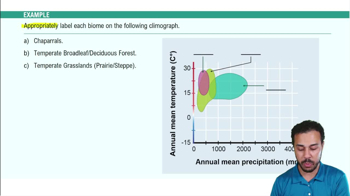
Terrestrial Biomes: Temperate Regions Example 1
Evapotranspiration
Evapotranspiration is the process by which water is transferred from the land to the atmosphere by evaporation from soil and other surfaces and by transpiration from plants. It is influenced by temperature, humidity, and solar radiation. In ecological studies, higher evapotranspiration rates are often associated with increased plant growth and productivity, which can support greater species diversity.
Recommended video:
Guided course
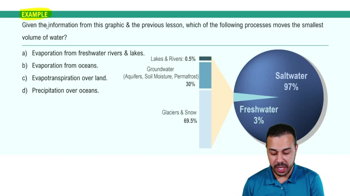
Biogeochemical Cycles Example 2
Related Videos
Related Practice








